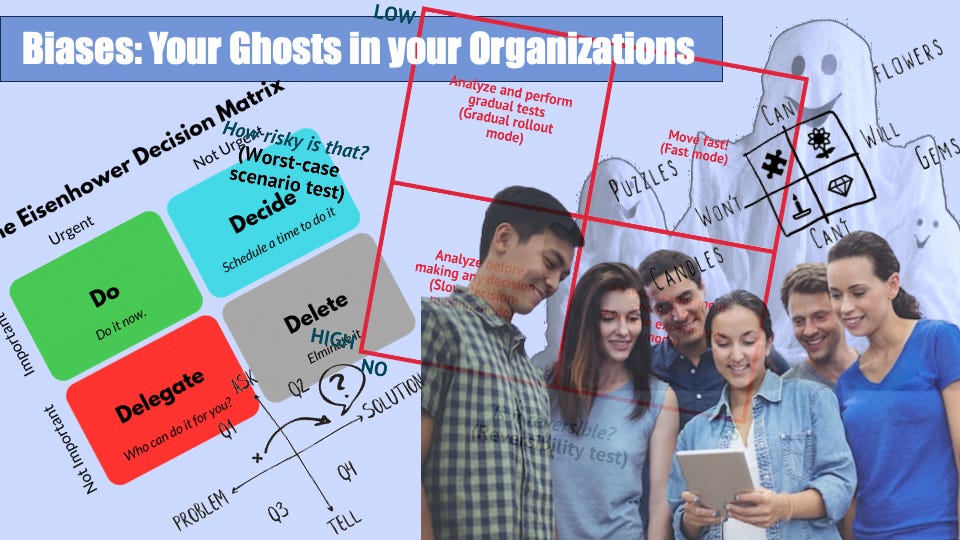Decisions make or unmake the organization. It’s the heart that beats. They determine its direction, shape its culture, and drive its success. From strategic choices to day-to-day tasks, decisions shape the trajectory of an organization's growth. They are often made by individuals in positions of authority, influenced by a variety of factors such as available information (and data!), personal experiences, and organizational goals.
But hold on!
Decisions aren't always made in a vacuum. They’re not the culture nor the DNA of the organization. They’re the unseen influencers (our “ghosts,” if you like) of our decisions. They are our organization biases.
Biases are mental shortcuts that our brains use to process information quickly. They evolved in time to help us navigate an uncertain and complex world efficiently. They might have worked for us many times in the past. And even so, recently. But they can inadvertently lead to poor decision-making habits when applied in organization playgrounds.
Common biases that lurk within the confines of our organizations are:
Confirmation Bias: The tendency to favor information that confirms existing beliefs while ignoring conflicting data. In organizations, this bias can lead to wearing blinders to problems and killing off any chance of thinking outside the box. A myopic view of possibilities and challenges that may hinder innovative thinking.
Anchoring Bias: The reliance on the first piece of information encountered when making decisions. This can lead to skewed judgments, especially in negotiations and financial planning.
Availability Heuristic: Relying on information that is readily available rather than seeking out all relevant data. In organization context, this can mean rushing into choices based on the latest easy-to-get information. May result in hasty decisions.
Groupthink: Following the herd, even if it means chucking critical thinking out the window. This can stifle diverse perspectives and hinder the development of innovative solutions.
Overconfidence Bias: Overestimating our own abilities and the accuracy of your judgments. This can result in risky decisions that can overlook potential risks or even underestimate future consequences.
Survivorship Bias: Considering becoming a start-up founder or an entrepreneurial career because their easy? Well, these could be easy because you’ve seen or read so many successful cases. But the truth is, it's a mind trick! The few winners stick around, but millions who crashed and burned went off to try something else.
Gambler’s Fallacy: If a company invested in a winning strategy, and made more than expected, instead of playing it smart and considering it could keep going up, the organization panics and keeps the gains already made.
Organization Hiccups
When these “ghosts” visit your decision-making parties unexpectedly, they can lead the organization astray. For example.
Inefficient Resource Allocation: Biased decisions may lead to misallocation of resources, squandering time, money, and actions that are as useless as locking your doors to prevent the ghosts from visiting you on the eve of the Halloween.
Limited Diversity of Thought: When biases influence decisions, organizations risk overlooking valuable insights and perspectives from individuals with different backgrounds and experiences.
Inadequate Problem-Solving: Biases can narrow the range of potential solutions considered, hindering the ability to address complex challenges creatively.
Corporate Trust Takes a Hit: Biased choices that play favorites can wreck the webs of trusts and relationships among employees, leading to disengagement and morale going down the drain.
Sharpening Decision-Making
OD plays a pivotal role in addressing biases and enhancing decision-making processes. By creating a culture that values openness, learning, and continuous improvement, organizational development professionals can instigate positive changes. To enhance informed decision-making, organizations can adopt various approaches without getting too formal:
1. Raise Awareness and Provide Training: Start by acknowledging biases and educating decision-makers on their impact. Training programs that highlight different biases and their consequences can empower individual decision makers to make better choices.
2. Cultivate Diverse Decision-Making Teams: Form diverse (and agile) teams with various perspectives to lessen the impact of biases. A broad range of viewpoints can lead to more robust discussions and well-rounded decisions.
3. Implement Structured Decision-Making Processes: Use structured decision-making frameworks like scenario analysis and cost-benefit analysis. This helps individuals consider a broader range of factors before reaching conclusions. For example, the Pugh Matrix below. Download the Pugh matrix:.
4. Promote Open Dissent: Create an environment where differing opinions are encouraged and valued. This prevents groupthink and encourages healthy debates leading to comprehensive decisions.
5. Use Data-Driven Decision-Making: Rely on data and evidence rather than gut feelings to counteract biases. Implement systems to collect, analyze, and present data objectively to inform decisions.
6. Rotate Leadership Roles: Prevent a single person's biases from consistently shaping decisions by rotating leadership roles among employees. This practice also promotes skill development and cross-functional understanding.
7. Do Decision Audits: Periodically review major decisions to identify biases that may have influenced the process. This retrospective analysis can offer valuable insights for future improvements.
On with the Journey
Decisions are the building blocks of organizational success, but biases can distort their true potential. By acknowledging the presence of biases, educating the decision-makers, and implementing structured processes, organizations can navigate the intricate landscape of decision-making more effectively. OD, with its focus on culture, learning, and growth, is instrumental in addressing biases and transforming them into opportunities for advancement. In this journey, organizations move closer to a future where decisions are driven by knowledge, collaboration, and unbiased judgment.
NOTES:
1.November 22, OD Conversations via Zoom: SPIRITUALITY IN OD by Rev. Fr. Raymond Ruga, Ph.D. Superintendent of Apostolic Vicariate of Calapan Parochial Schools in Oriental Mindoro, Parish Priest, Blessed Trinity Parish, Oriental Mindoro, and Ph.D. in OD .Major in Transformative Spirituality (SAIDI)
2.Designing Effective OD Interventions on Nov 15 with Dr Miel Reyes
3.THE ODBOT. I am proud to announce that we have created our own ODBOT running on Llama 2 to 7 by Meta. Be the first to access the ODBOT here.




